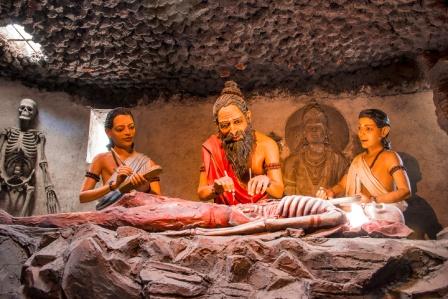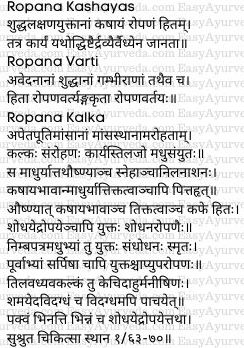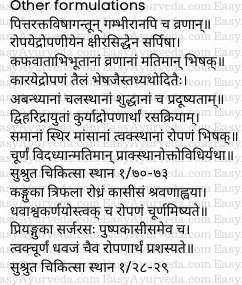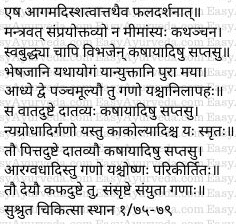Ropana Meaning, Procedure Of Treatment, Medicines Used
By Dr Raghuram Y.S. MD (Ayu) & Dr Manasa, B.A.M.S
Ropana means healing. Shodhana i.e. cleansing and Ropana i.e. healing are conducted simultaneously as far as ulcers and wounds are concerned. In fact, we can tell that healing occurs on the backdrop of cleansing. Shodhana and Ropana are two different treatments included in the Sapta Upakramas i.e. seven treatments wherein ropana has been mentioned after shodhana in the chronology.
All the above said 13 kinds of treatment are primarily cleansing in nature but the same treatments also bring about healing. Master Sushruta has explained Ropana in between avachurnana (dusting) and dhupana (fumigation) which are forms of cleansing treatments. But the master has not considered it as one of the treatments amongst shashti upakrama i.e. 60 kinds of treatment. Even amongst the 13 types of cleansing treatments it is not clear so as to which treatments belong to shodhana and which belong to ropana. Probably both these treatments are considered to be complimentary.
Read – Sushruta’s 7 Types of Treatments Sapta Upakrama

Table of Contents
Chronology of Shodhana, Ropana and Vaikrutapaha
Coming to the chronology, shodhana is done first and then ropana is done. The wounds / ulcers would get cleansed after shodhana. Those wounds are comprehensively healed by administering ropana treatment.
After the wounds and ulcers have totally healed vaikrutapaha, the seventh treatment measure from amongst sapta upakrama (7th in chronology, after ropana) should be done to remove deformities and sequels of ulcers and wounds if any, as a part and parcel of cosmetic rebuilding.
Read – Shashti Upakrama Meaning, Classification, Clinical Significance
Why Ropana has not been included separately in shashti upakrama?
Shashti Upakrama includes 60 treatment principles in surgical school, explained by Master Sushruta in Chikitsa Sthana section, chapter 1. They are magnified versions of Sapta Upakrama i.e. 7 treatments mentioned by Sushruta in 17th chapter of Sutra Sthana section. This means to tell that these 60 treatments are included under 7 major treatments. Ropana has been mentioned as 6th major treatment in the chronology of 7 treatments but has not been included amongst the 60 treatments. Where did ropana miss out?
Master Sushruta has probably considered shodhana and ropana as complementary treatments. So all 13 kinds of shodhana treatments also simultaneously heal the ulcers and wounds i.e. act as ropana. Explanation of Ropana has been interposed in between the explanation of penultimate and final treatment of shodhana treatments. It looks like pushed into the context with default but for Master Sushruta the purpose and idea of explaining the ropana measures there was very clear. The unsaid perspective is that shodhana treatments will serve the purpose of ropana most of the times. If shodhana treatments do not cleanse or heal the ulcers and wounds comprehensively then ropana should be considered for better and total healing. Even if the wounds are properly cleansed by shodhana, ropana should be included as the immediate next measure to hasten the healing process.
Read – Shashti Upakrama Meaning, Classification, Clinical Significance
Sanskrit Verses



Types
Types of Ropana (healing) treatments and conditions for administering
Ropana Kashayas
Healing Decoctions – administered in shuddha vranas i.e. the wounds / ulcers which have already been cleansed. Decoction of Vatadi group of herbs is used for this purpose. Healing medicines are administered after cleansing the ulcers for better healing of ulcers. So ropana is fortification of results of shodhana.
Ropana Varti
Healing suppositories / wicks – i.e. ulcer / wound healing suppositories is used in the ulcers which are devoid of pain, which are cleansed and deep seated. The wicks are prepared with healing herbs like Tinospora cordifolia, Withania somnifera etc.
Ropana Kalka
Healing medicinal pastes – applied in ulcers devoid of foul smelling muscles and the ulcers not getting healed in spite of being located in the muscles. Paste of sesame mixed with honey is used for this purpose.
The sesame paste being sweet, hot and unctuous destroys vata. Being astringent, sweet and bitter it combats pitta. Being hot, astringent and bitter it destroys kapha. When administered mixed with cleansing and healing herbs, this paste of sesame accomplishes the therapeutic actions of cleansing and healing the ulcers / wounds.
Sesame paste administered mixed with neem leaves and honey would cleanse the ulcers. The same sesame paste administered mixed with neem leaves, honey and ghee would cause healing of ulcers / wounds.
Barley Paste act in a similar way as that of sesame paste. This pacifies immature ulcers and causes suppuration of partially suppurated ulcers.
Other benefits of Barley paste
- It breaks open the suppurated ulcers.
- It cleanses and heals the open wounds.
Read – Charaka Vrana Chikitsa – 25th Chapter – Wounds, Ulcers
Other formulations
Ulcers caused by vitiated pitta, blood and poisons and from external causes and deep rooted ulcers should be healed by administration of ghee extracted from the milk prepared with healing herbs. The ulcers afflicted by vitiated kapha and vata is treated with oils prepared using healing herbs.
Rasakriya – semisolid preparation prepared using Curcuma longa and Berberis aristata is administered / applied in the ulcers associated with below mentioned conditions for the purpose of healing –
- Ulcers in which bandaging is contraindicated (ulcers formed by vitiated pitta, blood, poisons and injury)
- Ulcers located on the joints of the body
- Doshas which get contaminated in spite of getting cleansed
In the ulcers / wounds which are even, surrounded by hard muscles and located in the skin is healed using the herbal powder prescribed in Sutra Sthana section (Su.Su.37).
Ropana Churna (Su.Su.37)
The powder of the below mentioned is called ropana churna because it is used in healing the ulcers and wounds. The ingredients include –
- Kanguka – Panicum stalicum / Setaria italic (foxtail millet?)
- Triphala – Terminalia chebula, Terminalia bellirica, Emblica officinalis
- Rodhra – Symplocos racemosa
- Kasisa – green vitriol
- Shravanahvaya – Sphaeranthus indicus
- Dhava – Anogeissus latifolia
- Ashvakarna – Shorea robusta
Similarly the powder of the below mentioned shall be used for healing the ulcers –
- Priyangu – Callicarpa macrophylla
- Sarjarasa – Vteria indica
- Pushpa Kasisa – Green vitriol
- Dhava Twak – Bark of Anogeissus latifolia
Also,
The shodhana and ropana treatments need to be done without giving much thought, just like mantras are used for healing purposes.
The medicaments shall be used in one or the other forms as per need and utility. Those forms include decoctions, suppositories / wicks, paste, ghee, oil, semisolids or powder.
For treating the ulcers afflicted by vitiated vata, Laghu panchamula and Brhat panchamula group of herbs need to be used in the above said forms.
Ulcers afflicted by vitiated pitta, Nyagrodhadi and Kakolyadi gana group of herbs need to be used in the above said forms.
Ulcers afflicted by vitiated kapha, Aragvadhadi and Surasadi Gana groups of herbs shall be used in the above said forms.
Ulcers afflicted by mixed doshas, the above mentioned different groups of herbs need to be skillfully mixed and used in the above said forms.
Click to Consult Dr Raghuram Y.S. MD (Ayu)







